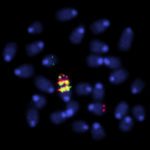Link to Pubmed [PMID] – 23994475
Cell Rep 2013 Sep;4(5):870-8
V(D)J recombination-associated DNA double-strand breaks (DSBs) are normally repaired by the high-fidelity classical nonhomologous end-joining (cNHEJ) machinery. Previous studies implicated the recombination-activating gene (RAG)/DNA postcleavage complex (PCC) in regulating pathway choice by preventing access to inappropriate repair mechanisms such as homologous recombination (HR) and alternative NHEJ (aNHEJ). Here, we report that RAG2’s “acidic hinge,” previously of unknown function, is critical for several key steps. Mutations that reduce the hinge’s negative charge destabilize the PCC, disrupt pathway choice, permit repair of RAG-mediated DSBs by the translocation-prone aNHEJ machinery, and reduce genomic stability in developing lymphocytes. Structural predictions and experimental results support our hypothesis that reduced flexibility of the hinge underlies these outcomes. Furthermore, sequence variants present in the human population reduce the hinge’s negative charge, permit aNHEJ, and diminish genomic integrity.

